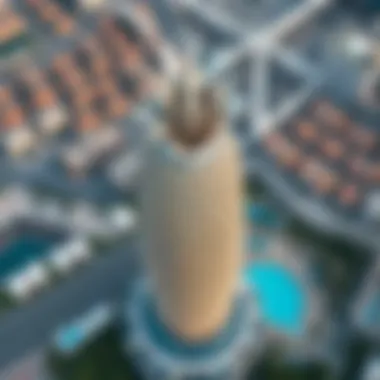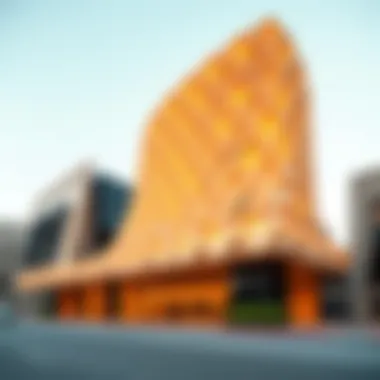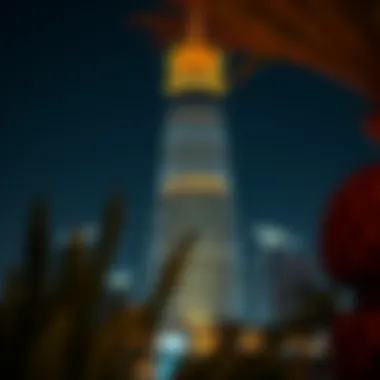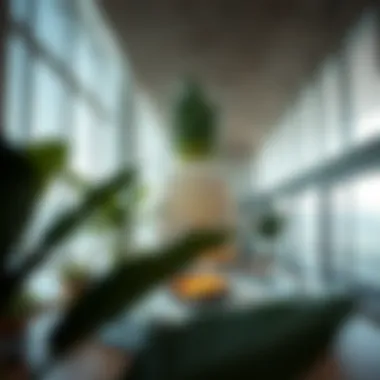Pineapple Building in Dubai: A Unique Architectural Wonder


Intro
The Pineapple Building in Dubai stands as a noteworthy symbol in the sprawling metropolis. This unique structure isn't just a feast for the eyes; it holds a deeper significance that intertwines with the cultural narrative of the region. Its design, a blend of modern architecture and traditional elements, sets it apart from the standard skyline of Dubai. As global cities continually evolve, this building challenges the norms, urging us to rethink what architectural marvels can signify.
This article aims to peel back the layers of this remarkable edifice and probe into its design philosophy, market implications, environmental consciousness, and the broader impact on Dubai's ever-bustling real estate landscape.
Market Trends
Current Real Estate Trends in Dubai
Dubai's property market has witnessed a dynamic shift in recent years. The allure of the Pineapple Building coincides with prevailing trends that showcase a growing demand for innovative and sustainable architecture. High-rise living is still prevalent, yet investors and buyers are now gravitating towards structures that narrate a story or reflect cultural motifs.
The Pineapple Building is a prime example; its design not only serves aesthetic purposes but functions as a social hub. These contemporary trends reveal that investors are leaning towards properties that offer more than just luxury; they want cultural relevance and environmental sustainability. Factors such as increased foreign investments and tourism continue to bolster the market, pushing it higher.
Future Projections and Insights
The skyline of Dubai is set for continued transformation. With urbanization at its peak, buildings like the Pineapple offer a glimpse into a future where architecture resonates with the community's heritage and aspirations. Investors should keep an eye on developments that follow this trend, as these properties are likely to appreciate significantly.
- Cultural Relevance: As the Pineapple Building suggests, future structures may need to reflect local culture to appeal more strongly to buyers.
- Sustainability: Eco-friendly designs are not a passing fad. More investors will favor properties incorporating sustainable materials and energy-efficient technologies.
"Properties that weave in cultural narratives and prioritize environmental responsibility are likely the ones to watch for long-term value."
Investment Opportunities
Key Areas for Property Investment
For anyone considering investing in Dubai's property market, certain areas are emerging as hotspots:
- Downtown Dubai: With its iconic skyline and proximity to key attractions, it continues to draw significant investments.
- Dubai Marina: Known for its luxurious lifestyle, this area appeals to both locals and tourists.
- Dubai Creek Harbour: The development here promises to be a centerpiece of Dubai's future urban landscape, making it ripe for investment opportunities.
Types of Properties to Consider
When looking to invest in properties around landmarks like the Pineapple Building, consider the following types:
- Mixed-Use Developments: These provide diverse opportunities, blending residential and commercial spaces effectively.
- Sustainable Homes: With rising buyer interest in sustainability, eco-friendly homes are becoming increasingly preferable.
- Luxury Apartments: Always in demand, especially when they can boast unique architectural features like those found in the Pineapple Building.
Keeping these insights in mind will provide a strategic advantage to investors, homebuyers, and real estate analysts navigating Dubai's continually evolving property landscape.
Preamble to the Pineapple Building
The Pineapple Building stands as a captivating testament to the evolution of Dubai's architectural identity. This iconic structure not only showcases modern design but also encapsulates the cultural ethos of a vibrant city that continuously pushes the envelope of creativity. The significance of understanding the Pineapple Building within this article lies in its unique architectural narrative, which fuses aesthetics with purpose, inviting both admiration and critical thought.
Overview of Dubai's Architectural Scene
Dubai, often dubbed as the city of superlatives, boasts a skyline peppered with some of the most extraordinary architectural feats in the world. From the soaring Burj Khalifa to the floating gardens of the Dubai Marina, the city thrives on innovation and ambition. Each building tells a story; a narrative crafted from the dreams and aspirations of those who envisioned them. The architectural landscape of Dubai is a mosaic that includes traditional designs and cutting-edge structures, effectively reflecting the city’s diverse cultural heritage.


Notably, the architectural scene here is marked by a relentless pursuit of luxury and uniqueness. Developers and architects are constantly chasing the next big idea, creating spaces that not only serve functional purposes but also connect with the public's imagination.
Among these milestones, the Pineapple Building emerges with its fruity flair, representing not just a step away from conventional design but also a pivot toward nature-inclusive architecture. The integration of verdant aesthetics into the steel and glass jungle has captured enthusiasts and investors alike, positioning this gem as an integral part of Dubai's progressive architectural narrative.
Inception of the Pineapple Building Concept
The concept of the Pineapple Building was born out of a desire to create a landmark that celebrates not only architectural innovation but also embodies a connection between nature and urban life. The initial sketches were not merely for a building but a vision that sought to redefine what an urban structure could represent. The design team intended to invoke feelings of happiness and warmth, much like the fruit from which it takes its name.
Inspired by the resilience and adaptability of the pineapple, the building symbolizes hospitality and elegance, which are qualities deeply woven into the fabric of Dubai’s culture. The idea was to think beyond the standard box-like structures, oftentimes seen in urban environments, and introduce a form that is organic, playful, and inviting.
As plans materialized into reality, the Pineapple Building blossomed into a blueprint rich with intricate details and sustainability features. Investors are drawn to the building not only for its unique aesthetic but also for its potential to stand as a keystone in Dubai's ongoing architectural dialogue.
"The Pineapple Building transcends conventional design principles and reveals a nuanced narrative that speaks to the heart of innovation in urban development."
By exploring these elements, this article aims to provide an intricate understanding of the Pineapple Building’s importance, celebrating its presence within the broader story of Dubai's relentless architectural exploration.
Architectural Design and Features
The architectural design and features of the Pineapple Building stand as a testament to modern creativity meshed with functional purpose. This unique structure isn't merely about aesthetics; it plays a crucial role in emphasizing both cultural symbolism and pragmatic utility. As Dubai continues to evolve into a global hub of investment and innovation, understanding the architectural intricacies of notable buildings like the Pineapple becomes a pivotal aspect for stakeholders in the real estate market.
Structure and Form
At first glance, the Pineapple Building captures attention with its distinct silhouette. The structure mirrors the familiar shape of a ripe pineapple, a design choice that makes it instantly recognizable amidst Dubai's skyline filled with glass and steel. The architects have taken great care in ensuring that the building's form isn’t just for show. Its shape is engineered to enhance airflow, thereby naturally cooling the space and reducing the reliance on energy-consuming air conditioning systems.
Additionally, the building's height has been meticulously calculated to optimize natural light during the day, reducing the need for artificial lighting. This clever structure doesn’t just stand out; it efficiently operates in harmony with the environment.
Innovative Use of Materials
Innovation in design is one part, but the materials used in constructing the Pineapple Building further elevate its architectural marvel status. The façade harnesses advanced composites that are not only durable but also incredibly lightweight. These materials reflect Dubai's ethos of embracing cutting-edge technology. Moreover, the use of smart glass plays a pivotal role in regulating indoor temperatures, preventing heat build-up during the harsh summers that the region is known for.
The application of locally-sourced materials emphasizes sustainability as well. This not only minimizes transportation emissions but also supports the local economy. When stakeholders see this dedication to quality and locality, it enhances the perceived value of the property, making it an attractive investment.
Sustainability Credentials
In today's landscape, sustainability is no longer an option; it’s a necessity. The Pineapple Building excels in this regard. It has earned multiple certifications for its environmentally-friendly design. The incorporation of solar panels on the building's roof is one significant feature, allowing for substantial energy savings and contributing to the grid during peak production times.
Water-conscious landscaping surrounds the building, featuring native plants that require minimal irrigation. This not only lowers water consumption but also provides a beautiful green space for both residents and visitors. Thus, the Pineapple Building is not just a place to live or work; it embodies Dubai’s commitment to sustainable urban living.
"Architectural brilliance is measured not just by how a building looks, but by how it interacts with and enhances its environment."
By prioritizing sustainability, the Pineapple Building appeals not only to potential homebuyers but also to green investors who are seeking projects that align with ecological standards. As the market trends shift toward sustainability, the building’s credentials will likely play a pivotal role in maintaining its value in the long run.
Cultural Significance of the Pineapple Shape
The Pineapple Building isn't just another architectural wonder in Dubai; it is a reflection of cultural narratives and historical contexts woven into its unique pineapple shape. This design choice goes beyond aesthetics; it embodies deeper meanings and connections that resonate with the city's identity and global standing.
Symbolism of the Pineapple in Architecture


Pineapples have long been viewed as symbols of hospitality and warmth across various cultures. In architectural contexts, the pineapple shape can represent the idea of welcoming spaces, inviting those who interact with the structure to engage with its surroundings.
- Historical Context: The pineapple's prominence as a sign of hospitality dates back to colonial times when it was an exotic fruit, often displayed as a centerpiece at lavish feasts. By embodying this imagery, the Pineapple Building aligns itself with the tradition of grace and opulence in hospitality—important traits in a city known as a global touristic hub.
- Modern Interpretation: In today’s society, the pineapple shape challenges conventional architectural forms by injecting an organic silhouette into the concrete jungle of Dubai. This departure from standard shapes can stimulate curiosity and conversation about design thinking and the conceptual basis of structures in an urban context.
When one glimpses at the Pineapple Building, it isn't just a striking figure in the skyline; it is a loud statement about merging functionality with rich cultural symbolism. It serves as a reminder that architecture can indeed express ideas, moods, and narratives.
Connection to Dubai's Heritage
Dubai's identity is already closely tied to its rich tapestry of history, influences from across the globe, and rapid modernization. The Pineapple Building acts as a cultural bridge, connecting modern architectural methods with traditional values.
- Cultural Reflection: The design's invitation to embrace the pineapple’s positive symbolism weaves well into the current trends. It resonates with the essence of Bedouin hospitality, representing sharing and welcoming qualities—traits deeply rooted in the emirate’s culture.
- Symbol of Growth and Unity: Additionally, the pineapple shape can be seen as a representation of growth. Much like how the pineapple fruit grows from a single fiber, this emblem speaks to the unity and progress of Dubai’s diverse community, merging various backgrounds into a shared architectural marvel.
Impact on the Urban Landscape
The Pineapple Building stands as a beacon amidst Dubai’s ever-evolving skyline. Its unconventional design and vibrant aesthetics serve not just as a marvel of architecture, but as a catalyst for the transformation of its urban surroundings. Understanding the impact this building has on the urban landscape reveals its critical role in enhancing city connectivity and embracing modern architectural trends.
Transformation of Surrounding Areas
The introduction of the Pineapple Building into Dubai’s architectural tapestry has led to noticeable transformations in the nearby areas. As this landmark secures a prominent space, it inevitably draws attention to its neighborhood, attracting both locals and tourists to explore the vibrancy of the district. Here are a few transformations experienced in its vicinity:
- Boost in Local Businesses: Positively impacted by the influx of visitors seeking to witness this architectural wonder, local eateries, shops, and markets have seen an increase in foot traffic, resulting in enhanced economic activity.
- Public Spaces Revitalization: With the development around the Pineapple Building, there's been a push to improve parks and recreational spaces. This has led to a more dynamic public life where community events and markets can flourish.
- Art and Culture: The building’s distinct style has prompted artistic endeavors in the surroundings. Murals and sculptures have begun to emerge, enhancing the area’s cultural offering and creating a vibrant artistic community.
The Pineapple Building, therefore, is not merely an architectural statement; it signifies a reawakening for the surrounding urban fabric, encouraging a blend of commerce, creativity, and community spirit.
Integration with Dubai's Master Plan
In the grand scheme of Dubai’s urban planning, the Pineapple Building is seamlessly woven into the city’s master plan. This integration underscores a commitment to fostering architectural innovation alongside sustainability. The following elements highlight this integration:
- Adherence to Zoning Regulations: The design conforms to Dubai’s strict zoning laws, promoting residential, commercial, and recreational spaces in a balanced manner. This helps maintain the orderly growth of the city while ensuring the Pineapple Building is a focal point.
- Promoting Eco-Friendly Practices: The building exemplifies Dubai’s vision for sustainable architecture by utilizing energy-efficient technologies. This move aligns with the government's push towards eco-friendly urban development, allowing it to contribute positively to the broader city agenda.
- Connectivity and Accessibility: Strategically located, the Pineapple Building enhances access via improved public transportation routes and pedestrian pathways, linking it effortlessly with other key parts of the city. It acts as more than just a physical structure but as a node within Dubai’s transport network.
Market Value and Investment Potential
Understanding the market value and investment potential of the Pineapple Building is crucial for various stakeholders including investors, homebuyers, and real estate professionals. This architectural gem isn't just a pretty face; it symbolizes a growing trend in Dubai's real estate market that marries innovative design with strong economic viability.
The Pineapple Building has set the stage for a potentially lucrative investment landscape. Beyond its aesthetic appeal, its unique design draws visitors, and that increased foot traffic can significantly enhance property values in its vicinity. The ability to attract and retain tenants is pivotal, especially in competitive markets.
Often, the value of a unique property can appreciate faster than typical investments, particularly in a city like Dubai, which constantly seeks to make a mark globally. Let's break down how this plays into the valuation and demand.
Property Valuation Insights
Property valuation for the Pineapple Building incorporates various elements. Key factors that influence its market value include:
- Location: Being located within an upscale area of Dubai, the property benefits from proximity to both commercial and recreational hubs.
- Architectural Significance: The Pineapple Building’s unique design enhances its marketability, making it a sought-after address.
- Accessibility: Close proximity to major transport links and amenities only enhances its attractiveness.
- Comparative Market Analysis: Analyzing similar properties provides insight into the price range and investment attractiveness.
Specifically, properties with distinctive designs tend to command premium prices. For example, recent trends indicate that iconic structures in Dubai, like the Burj Khalifa, have significantly driven up land prices in their surrounding areas. Therefore, as the Pineapple Building stands out with its vibrant and bold design, similar price appreciation can be anticipated.
Rental Yields and Market Demand


When assessing the rental yields for the Pineapple Building, the market demand is a vital consideration. Investors typically focus on:
- High Rental Demand: Due to its status as a unique architectural landmark, interest from both residents and businesses is likely to remain high.
- Potential for Short-Term Rentals: Tourists and business travelers seeking distinctive accommodations can be drawn to the building, enhancing short-term rental options.
- Competitive Rental Rates: The ability to set competitive rental rates based on demand and market conditions is essential.
In Dubai, the rental market has shown resilience, with recent data from various sources indicating stable growth. By capitalizing on the Pineapple Building's appeal, owners might find they can command above-average rates compared to standard apartment complexes or commercial buildings.
"Location, design, and market behavior are all interdependent factors in determining the success of any investment. The Pineapple Building encapsulates this notion perfectly."
Future Prospects and Developments
Looking into the future, the Pineapple Building not only stands as an architectural marvel, but it also holds potential for transformative impact within Dubai's rapidly evolving real estate landscape. The discussions surrounding the future developments of this striking structure revolve around several key areas including harmonizing with market trends, enhancing the building's aesthetic and functional aspects, and integrating further eco-friendly technologies. Each of these driving forces serves as a guiding star toward realizing the full potential of the Pineapple Building, both as an investment opportunity and a cultural icon.
Rising Trends in Dubai Real Estate
Dubai's real estate market is witnessing notable changes as it aligns itself with global trends that encompass sustainability, luxury, and urban living. As investors and homebuyers look toward properties such as the Pineapple Building, several rising trends merit attention:
- Integration of Smart Technology: As technology becomes increasingly integrated into everyday living, potential developments in the Pineapple Building may include automation systems that enhance comfort and efficiency.
- Focus on Sustainable Living: With an emphasis on environmentally sound construction, developers are now prioritizing the inclusion of renewable energy sources, green spaces, and water conservation mechanisms in property design. The Pineapple Building is well-positioned to embody these principles and could lead the charge for sustainable architecture in the region.
- Luxury Lifestyle Offerings: High-net-worth individuals are looking for residences that provide luxury and lifestyle benefits. Features like exclusive amenities, proximity to cultural hotspots, and breathtaking views will likely be integral to future enhancements.
It’s crucial for stakeholders to stay abreast of these trends, not just for practical reasons but also to continually elevate the status of the Pineapple Building within Dubai's prestigious architectural panorama.
Expected Enhancements to the Building
To maintain its standing as a landmark, the Pineapple Building is set to undergo several enhancements that cater to evolving demands:
- Vertical Gardens and Green Terraces: Encouraging biodiversity and improving air quality, vertical gardens may soon ascend its bold facade. These green spaces could provide a serene escape from the bustling city life below.
- Cultural and Community Hubs: Plans might include the creation of spaces dedicated to arts, crafts, or local cuisines, thus deepening the connection between the building and the community.
- Advanced Facade Treatments: Innovations in facade technology could offer improved insulation and aesthetic value, possibly incorporating dynamic surfaces that respond to environmental conditions.
As these expected enhancements unfold, the Pineapple Building is poised to become a beacon for innovative living, blending architectural beauty with functionality, while also appealing to a discerning clientele looking for investment opportunities in Dubai.
Considering all these aspects, it’s clear that the future prospects of the Pineapple Building do not merely hinge on aesthetic appeal. Instead, its growth incorporates thoughtful enhancements that hold substantial promise for both residents and investors, ensuring that it remains a significant player in Dubai's dynamic real estate market.
Closure
Recap of the Building's Importance
The Pineapple Building stands tall as a beacon of modern architecture in Dubai, embodying the city’s zest for innovative design and cultural significance. This architectural gem has not only redefined the skyline but also offered a fresh perspective on integrating local heritage into contemporary structures. The playful pineapple silhouette serves as a symbol of hospitality, a nod to both the city’s welcoming spirit and its rich history in trade and commerce.
When looking at its significance, one cannot overlook how the Pineapple Building enhances the visual and cultural landscape of its surroundings. It is more than just a structure; it encapsulates the ethos of Dubai itself—a city constantly reinventing and redefining its identity. For investors and property enthusiasts, the Pineapple Building presents an opportunity that goes beyond mere aesthetics; it is a strategic investment in a location that is rapidly evolving, promising sustained engagement in the future.
Final Thoughts on Investing in Iconic Architecture
Investing in iconic architecture, such as the Pineapple Building, transcends the mere act of buying property. It's about aligning oneself with a narrative, a forward-thinking vision that resonates on multiple levels. Such buildings often generate interest not just from local buyers, but also attract global investors looking to add prestige to their portfolios.
The unique design features and cultural connotations create a distinct profile that appeals to a wide range of tenants, increasing rental yields which are crucial in today’s competitive market. This can mean a substantial return on investment in both short and long term.
Some key considerations when investing in architectural wonders include:
- Cultural Relevance: Properties that tell a story often have higher demand.
- Sustainability Aspects: Eco-friendly features can drive up appeal.
- Location: Proximity to development plans and urban hubs can signify future value.
By investing in such striking landmarks, individuals and companies position themselves not merely as users of space, but as custodians of art and history within a dynamic urban setting. Thus, the Pineapple Building is not just another property; it's a significant real estate masterpiece that holds promise and prestige in Dubai's ever-changing landscape.
"An investment in iconic architecture can mean joining a legacy and also shaping futures."
For those considering such investments, be sure to research thoroughly, engage with real estate specialists, and always keep an eye out for upcoming developments that may also add value to your investment.















